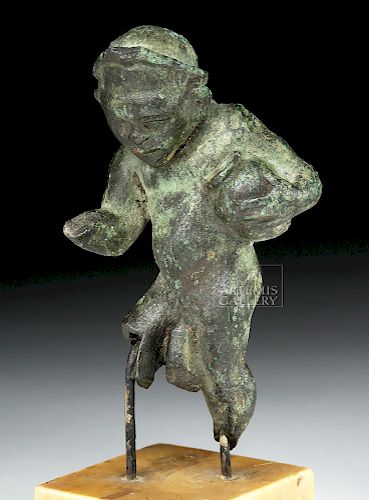Superb Roman Egypt Bronze Male Dwarf Figure
Lot 62b
About Seller
Artemis Gallery
686 S Taylor Ave, Ste 106
Louisville, CO 80027
United States
Selling antiquities, ancient and ethnographic art online since 1993, Artemis Gallery specializes in Classical Antiquities (Egyptian, Greek, Roman, Near Eastern), Asian, Pre-Columbian, African / Tribal / Oceanographic art. Our extensive inventory includes pottery, stone, metal, wood, glass and textil...Read more
Categories
Estimate:
$5,000 - $7,000
Absentee vs Live bid
Two ways to bid:
- Leave a max absentee bid and the platform will bid on your behalf up to your maximum bid during the live auction.
- Bid live during the auction and your bids will be submitted real-time to the auctioneer.
Bid Increments
| Price | Bid Increment |
|---|---|
| $0 | $25 |
| $300 | $50 |
| $1,000 | $100 |
| $2,000 | $250 |
| $5,000 | $500 |
| $10,000 | $1,000 |
| $20,000 | $2,500 |
| $50,000 | $5,000 |
| $100,000 | $10,000 |
| $200,000 | $20,000 |
About Auction
By Artemis Gallery
May 10, 2018
Set Reminder
2018-05-10 10:00:00
2018-05-10 10:00:00
America/New_York
Bidsquare
Bidsquare : Fine Ethnographic / Asian / Ancient Art
https://www.bidsquare.com/auctions/artemis-gallery/fine-ethnographic-asian-ancient-art-3213
Featuring antiquities from around the world including Pre-Columbian, Tribal, Classical, Asian, so much more! Artemis Gallery info@artemisgallery.com
Featuring antiquities from around the world including Pre-Columbian, Tribal, Classical, Asian, so much more! Artemis Gallery info@artemisgallery.com
- Lot Description
Roman controlled Egypt, Late Ptolemaic to Roman Period, ca. 1st Century BCE to 1st Century CE. An intriguing cast bronze sculptural figure representing a male dwarf or possibly a Satyr, holding a vessel in his left hand, his body captured in motion with his right leg advancing before his left, his right arm outstretched, and his head looking downward. His head is disproportionate with the scale of the rest of his body, and he has a large, rounded stomach. An enigmatic figure with intriguing dimensions that certainly demonstrate his dwarfism. Gorgeous green patina. Size: 3.25" H (8.3 cm); 4.375" H (11.1 cm) on included custom stand.
This piece's iconography and stylistic interpretation is characteristic of Hellenistic bronze dwarf figures. In her article about a bronze statuette of a dwarf in the Metropolitan Museum of Art in New York City, Lillian Bartlett Stoner of the Institute of Fine Arts, New York University writes, "Small-scale bronze statuettes of dwarfs, of which one in The Metropolitan Museum of Art is an important example were frequently displayed in Roman domestic settings and seem to have been particularly popular during the Late Republican and Early Imperial periods (ca. 100 B.C. - A.D. 100). In this context, images of dwarfs were emblematic of the mania for all things 'Egyptian' that reached a fever pitch in the decades leading up to and following the Battle of Actium in 31 B.C." (Lillian Bartlett Stoner, "A Bronze Hellenistic Dwarf in the Metropolitan Museum" Metropolitan Museum Journal 2015 50, 92-101.)
Provenance: private East Coast, USA collection
All items legal to buy/sell under U.S. Statute covering cultural patrimony Code 2600, CHAPTER 14, and are guaranteed to be as described or your money back.
A Certificate of Authenticity will accompany all winning bids.
We ship worldwide and handle all shipping in-house for your convenience.
#132492Ancient losses to right forearm, both legs, and tip of headdress. Beautiful green patina has developed over the centuries.Condition
- Shipping Info
-
All shipping is handled in-house for your convenience. Your invoice from Artemis Gallery will include shipping calculation instructions. If in doubt, please inquire BEFORE bidding for estimated shipping costs for individual items.
-
- Buyer's Premium



 EUR
EUR CAD
CAD AUD
AUD GBP
GBP MXN
MXN HKD
HKD CNY
CNY MYR
MYR SEK
SEK SGD
SGD CHF
CHF THB
THB















